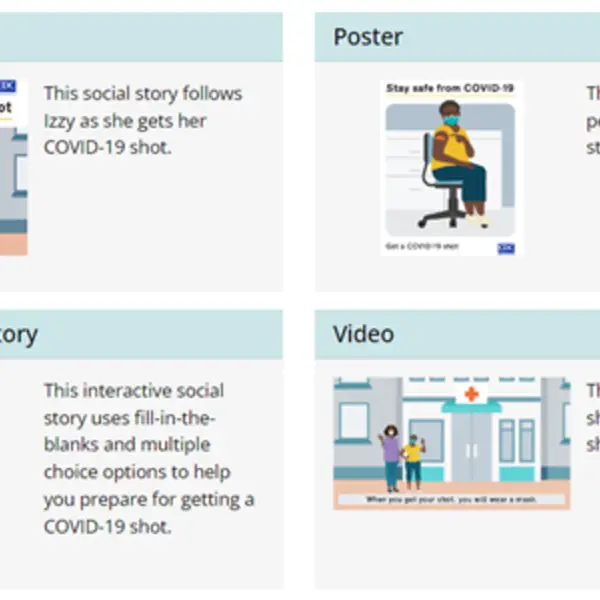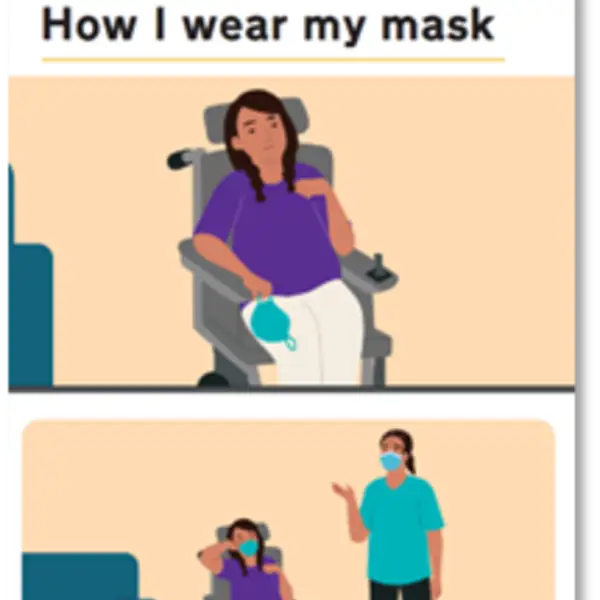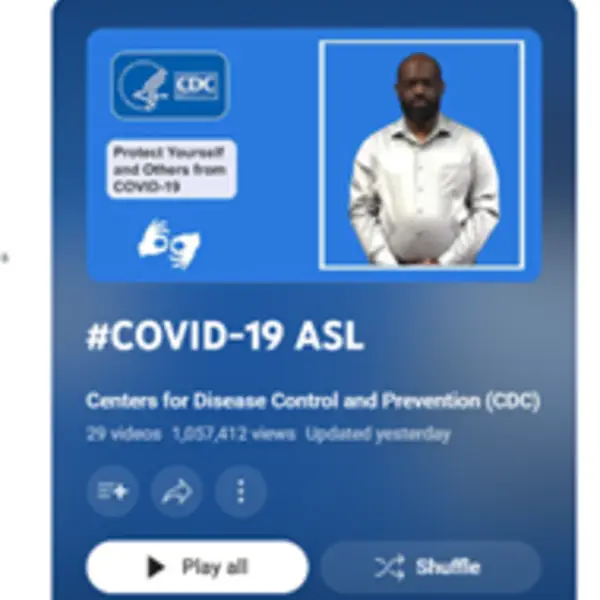Developing COVID-19 materials for people with intellectual disabilities, people who use American Sign Language, and people who use braille
Objective
To communicate important COVID-19 information through resources in accessible formats, including Easy to Read, American Sign Language, and braille.
Approach
RTI engaged individuals with accessible communication needs and their families, as well as key organizations that serve them, to develop relevant and accessible COVID-19 materials for people with intellectual and developmental disabilities, people with limited literacy, people who use ASL, and people who use braille.
Impact
RTI developed more than 75 materials—significantly expanding the availability of the Centers for Disease Control and Prevention’s (CDC’s) COVID-19 materials in accessible formats—that reached more than 2 million people through targeted dissemination.
Addressing COVID-19 Challenges with Accessible Communication
Understanding individual COVID-19 risk and prevention is critical to prevent the spread of the virus. Millions of people require some form of accessible information that is clear, actionable, and appropriate for their needs. However, few such COVID-19 resources existed in 2020, particularly for those with disabilities. To address this gap, CDC funded the development of COVID-19 information in accessible formats.
One in four American adults reports having at least one physical, intellectual, or developmental disability. The COVID-19 pandemic disproportionately impacted people with disabilities and widened existing health challenges. For many people with intellectual and developmental disabilities (IDD), these were compounded by literacy limitations, such as extreme low literacy (ELL), that made it challenging to access, understand, and act on critical COVID-19 prevention information. For Spanish-speaking people with IDD and people who communicate using American Sign Language (ASL) or braille, finding accessible and appropriate COVID-19 resources was even more challenging.
Using our substantial experience in engaging people with disabilities and/or literacy limitations and creating award-winning materials, RTI researchers and our partners at CommunicateHealth developed a multifaceted approach to increase accessibility and representation in health communication about COVID-19.
Developing COVID-19 Materials
Formative Research
RTI researchers began by defining three priority audiences:
- People with IDD and ELL. People with IDD are an audience with a vast array of communication needs and challenges. Our team focused on those with ELL, which includes a spectrum of individuals with literacy limitations, from those who understand common signs and images to those who can read basic books with pictures.
- People who use ASL. This includes people who are deaf, hard of hearing, or unable to speak and their families.
- People who use braille. This includes people who are blind or who have low vision.
To identify best practices for communicating with these three audiences, we conducted a literature review and environmental scan and interviewed individuals with accessible communication needs, their caregivers, and staff from key organizations that serve these audiences.
Material Development
The RTI and CommunicateHealth team developed a suite of new COVID-19 materials that were linguistically appropriate and met the varying communication needs of our target audiences. For those with IDD and ELL, we created easy-to-read content, including webpage text, social stories, interactive materials, and animated videos in English and Spanish. For those who communicate using ASL, we created an ASL video series covering important COVID-19 topics. For those who use braille, we translated COVID-19 vaccine guidance and communication products into digital and printed braille. To ensure that materials resonated with and represented a range of audiences, we considered a variety of intersecting barriers to COVID-19 vaccination and education, such as cost, health care delivery modes, and more.
Driving Impact with Accessible COVID-19 Communication
In 2020, very few COVID-19 resources existed in accessible formats, and hardly any had been tested with people with accessible communication needs. Working with CDC, we developed and disseminated 64 Easy to Read webpages, social stories, and animated videos in English and Spanish; 10 ASL videos; and 5 braille resources.
Using a mix of traditional and innovative dissemination techniques to promote materials to people who need them, we generated more than 2 million impressions targeting people with IDD and their caregivers, people who use ASL, people who use braille, and the organizations and health care providers that serve these audiences.
| Audience | Materials Developed | Platform / Strategy Used | # of People Reached |
|---|---|---|---|
| People with IDD and ELL | 64 easy-to-read webpages, social stories, and animated videos in English and Spanish | CDC hub landing page, paid and organic social media | 943,000 people with IDD and their caregivers |
| People who use ASL | 10 ASL videos | YouTube Playlist, paid ad placement, partnership with Sign1News and Daily Moth | 1.7 million people who use ASL |
| People who use braille | 5 printed braille resources | National Library Service for the Blind and Print Disabled | 116,000 people who use braille |
Throughout the formative research and dissemination process, we developed key partnerships with individuals and organizations that support people with accessible communication needs, including the following:
- Sign1News, a digital network that delivers news for the deaf and hard-of-hearing community
- The Daily Moth, a digital network that delivers news in video using ASL
- NFB-NEWSLINE, a free audio news service for anyone who is blind, low-vision, deafblind, or print disabled
- National Library Service for the Blind and Print Disabled, a free braille and talking book library service for anyone who is blind, low-vision, or print disabled
Our research also informed the development of an evidence-based Product Development Tool to help researchers, clinicians, and public health professionals create communication products for adults who have IDD/ELL (Squiers et al., 2023). In spring 2023, our team delivered four trainings to more than 400 communicators and visual designers at CDC on clear communication for people with IDD, people who use ASL, and people who use braille. As a result, CDC now has staff who are trained to develop materials rapidly for this audience in the event of future emergencies.
The Future of Accessible Communication
Through this project, we learned valuable lessons about developing and disseminating materials in accessible formats that can be leveraged for future emergencies:
- We learned that ASL media outlet partners were willing and excited to partner with CDC to share and promote the COVID-19 ASL videos. One of our partners, Sign1News, created a Public Health page for its audience, and the media outlet cited our partnership as the inspiration to build this page. The page will be used to share important public health information with the deaf and hard-of-hearing community.
- We learned that limited published information is available about best practices for disseminating health information to people who use braille. It is still unclear which material format or channel is best for reaching this audience, as people who use braille may also use digital braille, audio, and other assistive technologies.
In future research on clear communication best practices, we hope to identify the most effective dissemination strategies to ensure that materials get into the hands of people who need them, particularly during emergencies. Building a robust dissemination system will help ensure that people with disabilities have access to the information they need.
To take advantage of the resources developed during this project, visit the following links:
View Sample Communications





The team developed easy-to-read content, interactive materials, animated videos in English and Spanish, an ASL video series and digital and printed braille. To ensure that materials resonated with and represented a range of audiences, we considered a variety of intersecting barriers to COVID-19 vaccination and education, such as cost, health care delivery modes, and more.
The team developed easy-to-read content, interactive materials, animated videos in English and Spanish, an ASL video series and digital and printed braille. To ensure that materials resonated with and represented a range of audiences, we considered a variety of intersecting barriers to COVID-19 vaccination and education, such as cost, health care delivery modes, and more.
The team developed easy-to-read content, interactive materials, animated videos in English and Spanish, an ASL video series and digital and printed braille. To ensure that materials resonated with and represented a range of audiences, we considered a variety of intersecting barriers to COVID-19 vaccination and education, such as cost, health care delivery modes, and more.
The team developed easy-to-read content, interactive materials, animated videos in English and Spanish, an ASL video series and digital and printed braille. To ensure that materials resonated with and represented a range of audiences, we considered a variety of intersecting barriers to COVID-19 vaccination and education, such as cost, health care delivery modes, and more.
The team developed easy-to-read content, interactive materials, animated videos in English and Spanish, an ASL video series and digital and printed braille. To ensure that materials resonated with and represented a range of audiences, we considered a variety of intersecting barriers to COVID-19 vaccination and education, such as cost, health care delivery modes, and more.
- Centers for Disease Control and Prevention (CDC)
- CommunicateHealth




